What are warts? We will analyze the causes, diagnoses and methods of treatment in the article by a dermatologist with 37 years of experience.
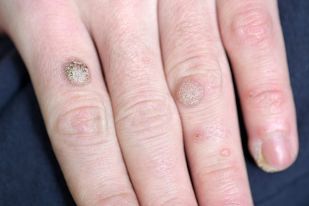
Definition of disease. The cause of the disease
Wartsare mild, irregularly benign skin lesions in the form of excessive growth of the upper layer of the skin (epidermis) with papules (nodules) or plaques.
The incidence of warts in adults is 7-12%, in school-age children - up to 10-20%.
Warts are very similar to other skin growths. Usually, a person cannot diagnose his disease accurately, therefore, a dermatologist must seek advice to make a diagnosis.
Human papillomavirus is the cause of warts. This type of virus affects the type of warts that can develop. Thus, each type of human papillomavirus infects tissues at the most typical localization.
| Type HPV | Preferred localization |
Types of warts |
|---|---|---|
| 1 | Feet, knees, palms, hands, fingers |
Plantar and palmar warts, moderate warts |
| 2, 4 | Hands, fingers, knees, more rarely - feet |
Simple warts, sometimes plantar, palmar and mosaic warts |
| 3, 10 | Shins, hands, face | Flat warts |
| 7 | Hands, fingers | Butcher Warts |
| 5, 8, 9, 12, 14, 15, 17, 19-24 |
Face, arms, front stem |
Epidermodysplasia verruciform |
Infection with the virus usually occurs through contact - with direct contact between infected and healthy skin (for example, when shaking hands) or indirectly (through handshake, toys, etc. ). Thus, you can be infected with the human papillomavirus virus, which causes warts, in various places - on public transport, in schools, at work, at home, in high contact areas and humid environments (swimming pools, saunas, gyms). Minor trauma to the epidermis, where the virus enters, as well as inflammation of the skin, contributes to infection.
Also contributes to the appearance of warts:
- lack of immunity (including HIV infection);
- hot and humid environment;
- the need for professional relationships with meat and fish ("butcher's warts").
Some types of human papillomavirus virus are transmitted from parents.
But frogs and toads, despite the horror stories we often dread as children, are not contagious - this is one of the most popular myths about the disease, which has no basis.
If you experience similar symptoms, see a doctor. Do not cure yourself - it endangers your health!
Symptoms of warts
Symptoms will vary depending on the type of wart.
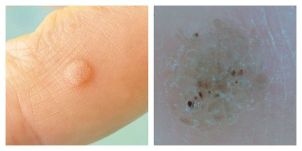
Normal warts:
- Round dense papule with normal color, 1-10 mm and more.
- The surface of the papule is covered with cracks, layers.
- If the papule is on the finger, the print will disappear and be distorted. The same is true for palm painting.
- Moderate warts are located either individually or in several parts - usually the warts are in the worst places (hands, fingers, knees).
- If viewed with a dermatoscope, the doctor may see small brown spots - pulsating capillaries (clogged). Patients often refer to these points as "roots". This is the main sign of a doctor: it can be used by a dermatologist to distinguish warts from other similar diseases (for example, molluscum contagiosum and keratoma).
Plantar warts (horns):
- The main symptom that usually causes patients to see a doctor is pain when pressing and walking.
- Such warts are usually located on the legs.
- When calling a doctor, usually, keratinous, uneven plaques of normal color can be seen, although in the first stage you can see even and smooth papules. With keratinization, capillaries can only be seen if the adhesive layer of skin is released.
- The skin pattern of the soles of the feet is distorted.
- Plantar warts are usually solitary, but there are also 2-6 warts;
- these warts are often confused with corn (especially dried) - this is a picture of a problem commonly seen by patients.
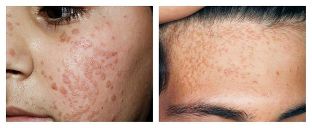
Flat warts (teens):
- Looks like round, clear and delicate papules with normal color, pink or brown, 1-5 mm in size.
- Appears on the hands, dry bones, very often on the face.
- There are usually some warts - they are located in groups.
Epidermodysplasia verruciform (senile warts):
- Neoplasms are large, round, numerous with normal pink or brown color.
- Usually appears on the face, arms, front of the torso.
- May be confused with keratoma, herpes zoster and skin cancer.
Pathogenesis of warts
Upon entering the body, the human papillomavirus virus can be dormant for a long time - one usually does not know about its existence. When favorable factors of the virus appear, it begins to "multiply" in the epithelium, leading to tissue changes.
Unlike other viruses, the human papillomavirus does not destroy the epithelial cells themselves - they die on their own, naturally, in the process of keratinization and exfoliation.
Local factors and the state of the immune system affect the spread of infection. For example, people with HIV infection or kidney transplants are more likely to have warts. Moreover, these neoplasms are often difficult to treat. With normal immunity, the virus does not affect the deep layers of the skin, so many people experience warts on their own after a few months.
The main stage of the appearance of warts is the acceleration of the rate of cleavage and cell growth with the help of viruses. This rapid metabolism causes the skin layer to thicken. As tissue grows in certain small areas, tubercles appear, called warts.
Classification and stage of development of warts
There is no universally accepted classification for warts. However, there are several common types:
- Normal wartsare the most common types (70% of warts are just them). Such neoplasms are not felt and only cause aesthetic discomfort in a person.
- Plantar warts- appear on the soles of the feet, are painful, therefore require treatment. Skin trauma due to uncomfortable, tight and cracked shoes contributes to the occurrence of such warts.
- Flat warts- more common in young people, teenagers. This is due to the unstable hormonal background of young people, which affects the whole body. Usually flat warts are almost invisible.
- Senile Warts- special for the elderly. They often appear on the part of the body covered with clothing, but can occur on the face and hands. If there is no discomfort, such warts cannot be treated - healing in the elderly can be slower than in younger people, due to slower metabolism.
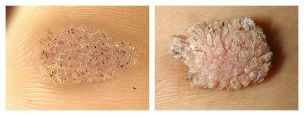
Other authors distinguish several types of warts like this:
- Mosaic warts(HPV 2, 4) - neoplasms on the palms and soles of the feet. They look like the focus of hyperkeratosis, which is the thickening of the stratum corneum (usually in the front leg), closed with deep crevices.
- Cystic warts(HPV 60) is a very rare type of growth in the legs. This is a soft knot with cracks. Once opened, the white-yellow discharge looks similar to curd.
- Filiform wartsare the growth of thin horns near the mouth, nose, or eyes.
- "Butcher" Warts(HPV 7) - appears on the hands and fingers of people who are in constant contact with meat and fish. Presented as a hypertrophic neoplasm similar to cauliflower, but of normal color.
In addition, the types of warts are differentiated depending on their location.
For example, anogenital warts - tumor-like neoplasms that appear on the genitals (especially in areas where the skin moves to the mucous membranes) are a common disease. They are usually caused by HPV types 6 and 11.
Complications of warts
The main reason why patients with warts go to the doctor is an aesthetic defect that can affect the patient's quality of life, self-confidence and develop many complexes. Complications include cracking of the wart surface and increased infection, and in some types of warts, pain during walking.
Skin warts usually do not degenerate into malignant neoplasms, they are harmless, however, in very rare cases, such complications can still occur in people with suppressed immunity.
Other complications arise when you try to remove the growth itself. Accordingly, inflammation and aesthetic defects in the form of scars may occur, as well as the further spread of the virus through the skin, because in the morning, after removing one wart, a person may wake up with some new ones.
Remember that with camouflage disguise, completely different diseases can be hidden, which cannot be determined without the advice of an experienced doctor.
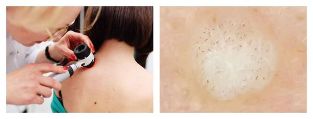
Diagnosis of warts
Examination (clinical picture) and history (medical history) are usually sufficient to make a diagnosis.
To confirm the diagnosis, the doctor can perform a histological examination - a study of neoplasm cells.
It is very important to make a differential diagnosis - to distinguish warts from other diseases. For example,normal wartsmust be distinguished from the following diseases:
- Molluscum contagiosum- more common on the body and genitals, less common on the hands and feet. It is a hemisphere with an effect on the surface; when pressed from the side, the whiteness "gruel" is released.
- Epidermal warty nevus- more often alone, a person from birth. It rises above the surface of the skin, often covered with hair.
- Basalioma- tumor in the form of a nodular roller, covered with a crust in the middle. Special for the elderly.
Palmar-plantar wartsmust be distinguished from the following diseases:
- Keratoderma- a large area of keratinization and inflammation of the skin. No frozen capillaries.
- Palmar-plantar syphilides- various painless neoplasms, peeling skin along the edges. The reaction to syphilis is positive.
- Corn- usually painless, can only cause pain when pressed vertically.
Doctors must also distinguish other types of warts from a number of diseases. If another pathology is suspected, he or she may prescribe additional diagnostics (for example, antibody detection of the virus, CT or MRI).
Treatment of warts
Warts are treated for aesthetic purposes and to improve the quality of life of patients. It can only be prescribed by a doctor after an accurate examination and diagnosis. An independent attempt to get rid of warts is unacceptable, as patients without the necessary medical education and equipment are unable to accurately diagnose the disease, and complications after such "treatment" occur more frequently than recovery.
There are several ways to treat warts. All of them are usually carried out under the supervision of a doctor, and some of them - only in the clinic treatment room.
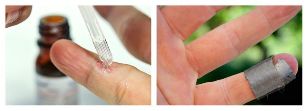
Chemical treatment
Milk-salicylic colodion and salicylic patches are used to get rid of warts. Percentage of drugs and methods of use (long-term application of plaster, application, etc. ) Depending on the prevalence and localization of neoplasms.
Zinc and 2-chloropropionic acid solutions can also be used. In this case, a chemical composition is applied to the previously treated surface, which is left on the wart until its color changes (depending on the type of wart). The procedure was repeated several times after 7, 14 and 21 days. Before each procedure, the tissue is removed mechanically.
Other chemical methods are a combination of nitric acid, acetic acid, oxalate, lactic and copper nitrate tritrate hydrate. In this way, only relatively small neoplasms are treated - up to 5 mm. The solution is also left to change the color of the wart. After 3-5 days, the patient comes for a follow-up appointment, if necessary, he undergoes a second procedure in 1-4 weeks.

Cryod Crash
This method consists of freezing the wart with liquid nitrogen: a damp swab is applied to the damaged skin (by catching the surrounding tissue a few mm) for 1-5 minutes. Some wounds require some treatment for four weeks to be destroyed.
The main disadvantage of cryodestruction production is the pain and its delayed effect compared to other methods, where only one procedure is sufficient for removal.
Electrocoagulation
Under the influence of electric current, warts are removed in layers. Such operations are performed under local anesthetics.
This method is more effective than the production of cryodestruction, but it has a significant drawback: electrocausts often leave scars at the wart site. For patients looking for cosmetic repairs,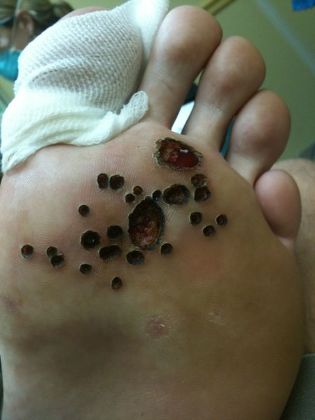 this method will not be the most suitable.
this method will not be the most suitable.
Laser destruction
Lasers also remove warts on the lining. Light indicators contact the skin from a few seconds to three minutes, depending on its size. Then the scabies that appear are cut, and the bottom of the wound is treated with a laser again. The patient is then instructed on how to deal with the wound. The operation itself is performed under the influence of local anesthesia.
Radio wave surgery
Radio wave surgery is one of the most modern and gentle methods to remove some benign neoplasms, including warts.
This method is based on the production of electromagnetic waves with different frequencies: from 100 kHz to 105 MHz. During the procedure, the tissue withstands late waves, which is why molecular energy is released in the cell, which warms the skin. Under the influence of heat, the cells actually evaporate - neat cuts are obtained. At the same time, no mechanical force is applied to the affected tissue.
Advantages of this method:
- security;
- rapid wound healing;
- good cosmetic effect - scars and scars are not included;
- relative pain - local anesthetic used before mini surgery;
- exclusion of secondary infection due to automatic electrode disinfection while the device is switched on.
The effectiveness of this method is recognized worldwide, but it is quite difficult to find clinics that use radio wave surgery methods.
Which treatment method should be chosen
All of the above methods have some drawbacks:
- In the first few weeks, the treated area looks unattractive - the crust, the tissue darkens. This should be taken into account if warts are present on the visible part of the body (for example, on the face).
- Unpleasant odor and some degree of pain during surgery.
But the main drawback is thepossibility of recurrence, especially if the warts are widespread, extensive. With each of these methods, doctors do not fight the cause of the disease, but as a result, as of todayhuman papillomavirus cannot be cured.
Therefore, therapy is aimed at:
- or destruction of neoplasms that appear on virus identification pages;
- whether to stimulate the antivirus immune response;
- or a combination of these approaches.
Often destructive treatments are used. Their efficiency reaches 50-80%.
Children are usually not a contraindication for surgical treatment. Therefore, many of them (including radio wave surgery) are also used to treat warts in children. The exception is chemical removal of warts due to possible adverse reactions to the substance.
What to do after surgery
Be sure to follow your doctor's advice after undergoing this operation.
After tumor removal with the specified method, the doctor usually prescribes treatment at the site of removal. It is forbidden to remove the "crust" itself, wet the wound and display it in direct sunlight.
If the patient has warts, he should see an immunologist - drug therapy may be needed, which will increase the immunity to the manifestations of the human papillomavirus virus.
Prediction. Prevention
If the patient does not have an immune deficiency, then the warts can go away on their own, but this can take a long time - from a few months to a few years. Thus, in 65% of cases, the warts independently deteriorate within two years. If after two years the warts are still there, then it is recommended to remove them. It is best to eliminate a lot of growth immediately.
With normal immunity and proper removal methods (depending on the size and type of wart), it is possible to remove pathogenic tissue and achieve a good cosmetic effect. With reduced immunity and other predisposing factors, human papillomavirus remaining in the body causes relapse.
There is no specific disease prevention. But is infection unavoidable?
You can reduce the chances of viruses if you follow a few rules:
- Avoid walking barefoot in public places where there is a possibility of skin injuries and viral infections (swimming pools, public baths, gyms).
- Choose quality shoes, change them often. Try to keep your feet dry. Heat and humidity are excellent breeding grounds for human papillomavirus.
- To avoid periungual warts, just go to a certified nail technician and make sure they use a sterile tool.
For the prevention of anogenital warts, according to the WHO (World Health Organization), the quadrivalent vaccine against human papillomavirus is also very effective. There is no vaccine available to prevent other types of warts.
If you find a wart, do not try to filter, cut or remove it yourself - this way you can contribute to the inflammation and spread of the virus to the skin. After such a "removal", instead of one wart in the morning, you can get up with ten.














































































